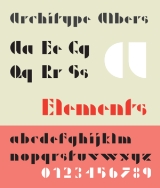
Architype Albers
Encyclopedia
Architype Albers is a geometrically constructed stencil sans-serif typeface based upon a series of experiments between 1926 and 1931 by Josef Albers
, German designer, educator and typographer, (1888–1976). The Architype Albers typeface is one of a collection of several revivals of early twentieth century typographic experimentation designed by Freda Sack and David Quay of The Foundry.
Albers studied art in Berlin, Essen, Germany, and Munich before enrolling as a student at the Weimar Bauhaus
in 1920. He began teaching in the preliminary course of the Department of Design in 1922, and was promoted to professor in 1925, the year the Bauhaus moved to Dessau. He taught there until the school was closed by the Nazis in 1933.
Albers designed a series of stencil faces while teaching at the Dessau Bauhaus. The typeface is based on a limited palette of geometric forms combined in a size ratio of 1:3. Drawn on a grid, the elements of square, triangle, and circle combine to form letters with an economy of form. Never intended for text, the face was designed for use on posters and in large scale signs.
Josef Albers
Josef Albers was a German-born American artist and educator whose work, both in Europe and in the United States, formed the basis of some of the most influential and far-reaching art education programs of the 20th century....
, German designer, educator and typographer, (1888–1976). The Architype Albers typeface is one of a collection of several revivals of early twentieth century typographic experimentation designed by Freda Sack and David Quay of The Foundry.
Albers studied art in Berlin, Essen, Germany, and Munich before enrolling as a student at the Weimar Bauhaus
Bauhaus
', commonly known simply as Bauhaus, was a school in Germany that combined crafts and the fine arts, and was famous for the approach to design that it publicized and taught. It operated from 1919 to 1933. At that time the German term stood for "School of Building".The Bauhaus school was founded by...
in 1920. He began teaching in the preliminary course of the Department of Design in 1922, and was promoted to professor in 1925, the year the Bauhaus moved to Dessau. He taught there until the school was closed by the Nazis in 1933.
Albers designed a series of stencil faces while teaching at the Dessau Bauhaus. The typeface is based on a limited palette of geometric forms combined in a size ratio of 1:3. Drawn on a grid, the elements of square, triangle, and circle combine to form letters with an economy of form. Never intended for text, the face was designed for use on posters and in large scale signs.

